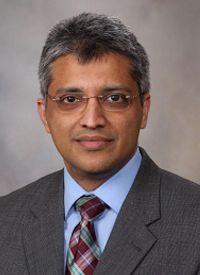Stem Cell Mobilization Strategies Call for Careful Consideration in Myeloma
Shaji Kumar, MD, discusses the role of stem cell transplant in multiple myeloma, different techniques for stem cell mobilization, and remaining challenges faced with this modality.
Shaji Kumar, MD, a consultant hematologist at the Mayo Clinic

Shaji Kumar, MD
Stem cell transplant, the only curative therapy for multiple myeloma, continues to be an essential part of treatment, according to Shaji Kumar, MD, but the method used to retrieve the cells must be considered carefully for each patient.
Choosing a method to mobilize stem cells, such as granulocyte-colony stimulating factor (G-CSF), the use of plerixafor in risk-adapted strategies, and chemomobilization, requires consideration of the type and the duration of therapy the patient previously received as well as the degree of disease control achieved, according to Kumar.
“Autologous stem cell transplant continues to be an integral part of myeloma therapy and should certainly be considered in every patient who is eligible to undergo this procedure,” said Kumar. “In patients who are undergoing stem cell transplant, we need to employ the right stem cell mobilization approach to enable us to obtain adequate numbers of cells for, at the minimum, 1 transplant. In younger patients, where we anticipate the use of more than 1 transplant, we should be able to collect for more than 1 transplant so that we can store some of it for the future.”
The biggest challenge still faced with stem cell transplants is that nearly all patients who undergo the procedure will still eventually relapse. To this end ongoing research efforts are investigating different mobilization methods to induce more durable responses in patients.
In an interview with OncLive, Kumar, professor of medicine and consultant in the Division of Hematology in the Department of Internal Medicine at Mayo Clinic, discussed the role of stem cell transplant in multiple myeloma, different techniques for stem cell mobilization, and remaining challenges faced with this modality.
OncLive: What is the role of stem cell transplantation in patients with multiple myeloma?
Kumar: Stem cell transplantation remains an important part of therapy in patients with multiple myeloma who are eligible to undergo the procedure. Patients up to 75 years in age [can be eligible for transplant] as long as they have good performance status and good organ function. The ability to collect stem cells for autologous stem cell transplantation is important in myeloma. A variety of different factors can affect the ability to collect stem cells, including the type and the duration of therapy patients received before they receive a stem cell transplant, as well as the degree of disease control [that they have].
In younger patients, we often try to collect adequate numbers of cells for 2 to 3 stem cell transplantations, which can then be used either as tandem autologous transplants or as a salvage autologous transplant at the time of relapse. It's important that we are able to collect adequate numbers [of cells] and a variety of different approaches have been tried. These include G-CSF—alone mobilization, the use of plerixafor in risk-adapted strategies, as well as the use of chemomobilization, all of which depend on the clinical context.
What do outcomes typically look like with these different techniques?
All the different approaches used for stem cell mobilization are successful in the majority of patients with myeloma. [However], when we use G-CSF—alone mobilization, we can get anywhere up to a 10% failure rate in patients with multiple myeloma. This rate goes up when patients have been treated for a prolonged period of time, and particularly if they have been exposed to drugs like lenalidomide (Revlimid) or alkylating agents, and more recently, newer drugs like daratumumab (Darzalex).
In patients who failed with the G-CSF—alone mobilization, we can use additional techniques like chemomobilization or mobilization using plerixafor, which is a CXCR4-targeted agent. In the context of chemomobilization, we are able to collect more cells than just G-CSF alone and the failure rate is lower as well; however, this does come with the increased cost and toxicity related to cytopenias, a longer time to mobilization, and the management of neutropenic fever if that requires hospitalization. With the use of plerixafor, especially when it is used in a risk-adapted strategy based on the CD34 counts after the G-CSF, or based on the number of CD34 cells collected with the first collection, we can reduce the failure rate to 1% to 2% in patients with multiple myeloma. All these different strategies have to be selected based on the particular patient and the clinical context.
What are the challenges faced with stem cell transplantation and how can the procedure be improved?
In the context of stem cell transplant for multiple myeloma, the biggest barrier or challenge is the fact that almost all these patients eventually relapse. We want to make the stem cell transplant as effective as possible, which involves the collection of adequate numbers of stem cells and utilizing the right approach, whether it be G-CSF alone, a risk-adapted strategy with plerixafor, or chemomobilization.
Another area of importance is the ability of the graft content to alter the outcomes of the transplant. The higher the absolute lymphocyte counts in the stem cell graph, the better the outcomes are in myeloma, as well as lymphoma. Ongoing studies are examining different mobilization strategies to see whether we can enrich the graft in certain immunologically-competent cells, which can then hopefully create a more durable response in these patients.



